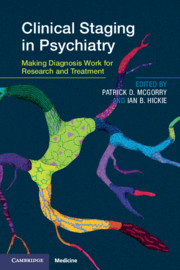Book contents
- Clinical Staging in Psychiatry
- Clinical Staging in Psychiatry
- Copyright page
- Contents
- Contributors
- Foreword
- Acknowledgements
- Section 1 Conceptual and Strategic Issues
- Chapter 1 Diagnosis without Borders
- Chapter 2 Clinical Staging and Its Potential to Enhance Mental Health Care
- Chapter 3 Time for a Change
- Chapter 4 A Moving Target
- Section 2 Progress with Clinical Staging
- Section 3 Novel Treatment Strategies
- Section 4 Novel Treatment Strategies
- Index
- Plate Section (PDF Only)
- References
Chapter 4 - A Moving Target
How Risk for Mental Disorder Can Be Modelled in Dynamic Rather than Static Terms
from Section 1 - Conceptual and Strategic Issues
Published online by Cambridge University Press: 08 August 2019
- Clinical Staging in Psychiatry
- Clinical Staging in Psychiatry
- Copyright page
- Contents
- Contributors
- Foreword
- Acknowledgements
- Section 1 Conceptual and Strategic Issues
- Chapter 1 Diagnosis without Borders
- Chapter 2 Clinical Staging and Its Potential to Enhance Mental Health Care
- Chapter 3 Time for a Change
- Chapter 4 A Moving Target
- Section 2 Progress with Clinical Staging
- Section 3 Novel Treatment Strategies
- Section 4 Novel Treatment Strategies
- Index
- Plate Section (PDF Only)
- References
Summary
Recently, there has been increased focus on sub-threshold stages of mental disorders, with attempts to model and predict progression to full-threshold disorder. Given this considerable research attention and clinical significance, it is timely to analyse the assumptions of theoretical models in the field. Research into predicting onset of mental disorder has shown an overreliance on one-off sampling of cross-sectional data (i.e., a "snapshot" of clinical state and other risk markers) and may benefit from taking dynamic changes into account. Cross-disciplinary approaches to complex system structures and changes, such as dynamical systems theory, network theory, instability mechanisms, chaos theory and catastrophe theory, offer potent models that can be applied to emergence (or decline) of psychopathology, including psychosis prediction and transdiagnostic symptom emergence. Staging provides a useful framework to research dynamic prediction in psychiatry. Psychiatric research may benefit from approaching psychopathology as a system rather than a category, identifying dynamics of system change (e.g., abrupt/gradual psychosis onset), factors to which these systems are most sensitive (e.g., interpersonal dynamics, neurochemical change), and individual variability in system architecture and change. The next generation of prediction studies may more accurately model the highly dynamic nature of psychopathology and system change, with treatment implications, such as introducing a means of identifying critical risk periods for mental state deterioration.
Keywords
- Type
- Chapter
- Information
- Clinical Staging in PsychiatryMaking Diagnosis Work for Research and Treatment, pp. 67 - 80Publisher: Cambridge University PressPrint publication year: 2019

